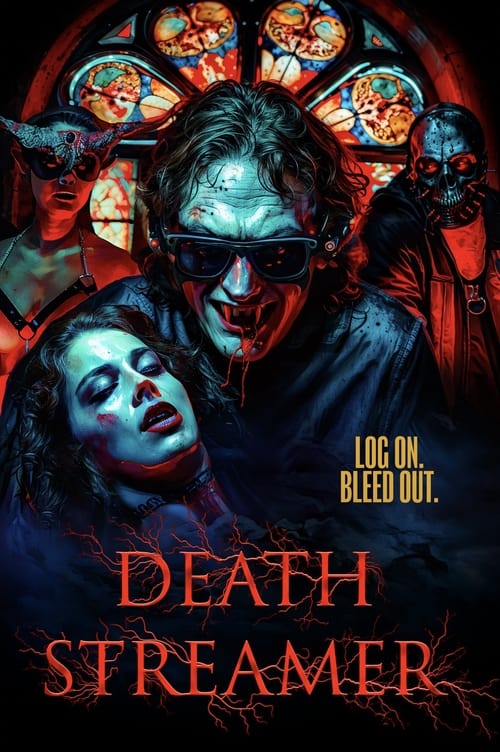Death Streamer – Film Review
Published October 17, 2024

Charles Band’s Death Streamer attempts to merge vampire lore with the internet age in a high-concept horror movie that sadly falls flat in execution. Despite its intriguing premise—combining vampirism with live streaming and a growing internet fandom—the film struggles to maintain momentum, coherence, or a sense of genuine terror. Co-written by Neal Marshall Stevens, this movie feels less like a fresh take on supernatural horror and more like a missed opportunity weighed down by uninspired performances, underwhelming special effects, and an overreliance on clichés.
The core premise of Death Streamer certainly has potential. A modern-day vampire named Arturo Valenor (Sean Ohlman) is equipped with technologically advanced glasses that allow him to traverse the real and virtual worlds, hunting victims and broadcasting their deaths online. He builds a grotesque cult of personality, where internet users become obsessed with watching him feed. In today’s culture of influencers and live-streaming, it’s easy to see how such a concept could resonate with a sense of voyeuristic horror.
Unfortunately, the film’s execution of this premise is disjointed. Rather than building a chilling atmosphere or investing time into developing the central concept, Death Streamer feels more like a series of violent vignettes loosely strung together. The pacing is erratic, lurching between scenes of Valenor’s live-streamed hunts and the efforts of three young supernatural investigators—Alex Jarvis (Aaron McDaniel), Juniper (Emma Massalone), and Kaitlin Moore’s unnamed character—who seek to bring him down.
The film never manages to strike a balance between horror, technology, and storytelling. Instead of giving viewers an immersive look into Valenor’s growing internet empire or his digital presence, the film bombards audiences with repetitive, formulaic scenes that do little to push the narrative forward.
Character development is one of the most significant weaknesses of Death Streamer. As a protagonist, Arturo Valenor is neither menacing nor memorable. Sean Ohlman’s portrayal of the vampire lacks charisma, and while he delivers on the creepy factor in a few isolated moments, his performance never reaches the level of chilling gravitas needed to make the character feel dangerous or compelling. Valenor’s motivations remain murky, and rather than diving into the psychology of a vampire who thrives on the attention of the digital age, the film merely scratches the surface.
Similarly, the trio of investigators who attempt to track down and stop the vampire are poorly fleshed out. Alex Jarvis, played by Aaron McDaniel, is the stereotypical leader who believes in supernatural phenomena, while Emma Massalone’s Juniper serves as the skeptic who eventually gets drawn into the horror. Kaitlin Moore’s character is so underdeveloped that she barely registers as anything more than an obligatory third wheel. The dynamic between these three is cliché and fails to add any emotional weight to their fight against the bloodthirsty streamer. Audiences are given little reason to care about their survival.
Death Streamer doesn’t shy away from blood, but the film’s overreliance on shock value becomes tiresome quickly. The streaming scenes—where Valenor feeds on his victims for the entertainment of his online audience—feel gratuitous rather than impactful. While there’s certainly a place for gore in horror films, Death Streamer fails to balance this with moments of genuine suspense or psychological terror.
The visual effects used for Valenor’s high-tech glasses and his virtual world pursuits are laughably cheap. Rather than adding a futuristic or unsettling edge, these effects come across as dated and amateurish, further pulling the audience out of the film. For a movie that aims to be about a tech-savvy vampire, it’s disappointing to see that the technology itself is represented so poorly on screen.
Moreover, the use of practical effects for the vampire’s feeding sequences feels more like an homage to low-budget 90s horror, which would be fine if the rest of the film supported this nostalgic aesthetic. However, Death Streamer doesn’t commit to a consistent style, leaving the gore scenes feeling more like afterthoughts meant to shock rather than scare.
While the film’s premise holds promise, the script does little to elevate it beyond basic genre conventions. Vampires hunting in the modern world is a theme that has been explored before, from Blade to 30 Days of Night, but Death Streamer fails to bring anything new to the table. The vampire’s use of technology is a fascinating idea, but it’s overshadowed by tired tropes like the overconfident investigator, the reluctant skeptic, and the inevitable showdown in an abandoned warehouse.
The lack of suspense is one of the film’s greatest downfalls. The investigators’ pursuit of Valenor never feels urgent or dangerous. Scenes that should be tense, such as the trio’s encounters with the vampire, are undercut by predictable outcomes and a lack of stakes. The film fails to generate a sense of dread or fear, which is crucial in horror. Instead, it relies too heavily on the concept of Valenor live-streaming his kills, which loses its novelty after the first few scenes.
Death Streamer is a film with a solid concept that’s wasted on poor execution. What could have been a chilling exploration of the intersection between technology and vampirism turns into a forgettable, low-budget horror film that relies too heavily on gore and clichés. The lack of character development, cheap effects, and failure to build suspense make Death Streamer a disappointment for horror fans looking for something fresh.
While it may find an audience among fans of Charles Band’s brand of schlocky horror, Death Streamer ultimately fails to deliver on its premise.
